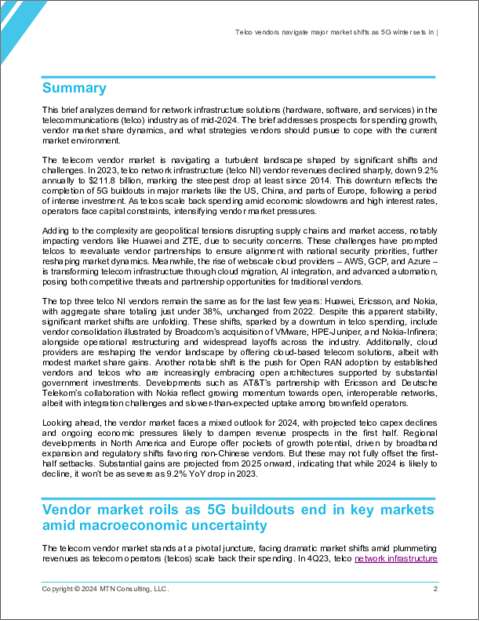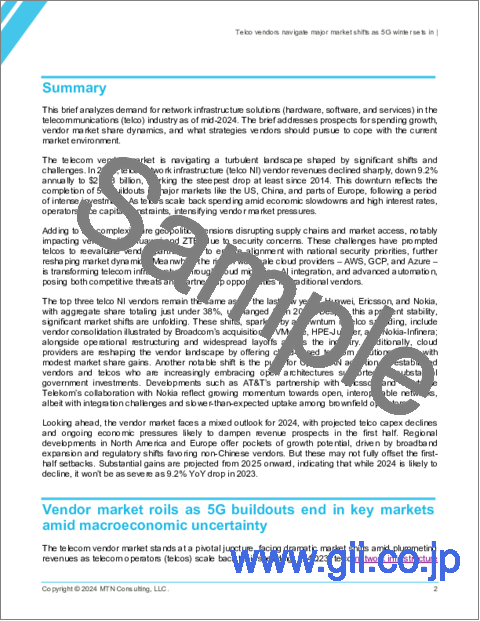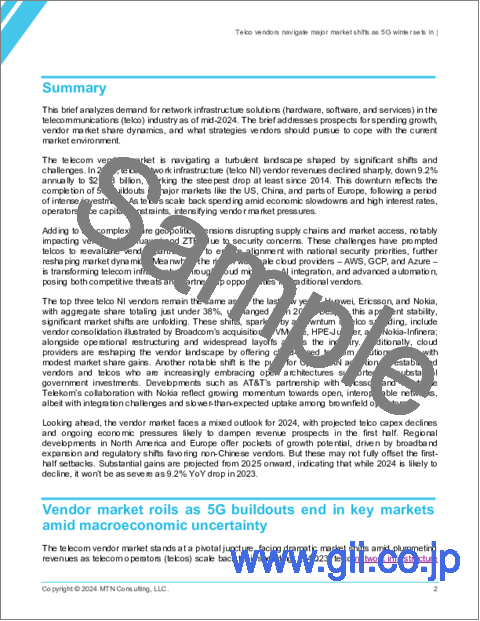|
|
市場調査レポート
商品コード
1512805
5Gの冬が到来する中、通信ベンダーは市場の大きな変化に対応:通信事業者の支出の低迷がベンダーの統合と運用見直しを引き起こし、オープンRANが牽引役となり、クラウド需要がアライアンスを後押しTelco Vendors Navigate Major Market Shifts as 5G Winter Sets In: Telco Spending Downturn Triggers Vendor Consolidation and Operational Overhaul, Cloud Demand Stokes Alliances as Open RAN Gains Traction amid Mixed Outlook |
||||||
|
|||||||
| 5Gの冬が到来する中、通信ベンダーは市場の大きな変化に対応:通信事業者の支出の低迷がベンダーの統合と運用見直しを引き起こし、オープンRANが牽引役となり、クラウド需要がアライアンスを後押し |
|
出版日: 2024年07月10日
発行: MTN Consulting, LLC
ページ情報: 英文 14 Pages
納期: 即納可能
|
全表示
- 概要
- 目次
2023年の通信ネットワークインフラベンダーの収益は、年率9.2%減の2,118億米ドルと、2014年以来の急激な落ち込みを記録しました。この落ち込みは、米国、中国、欧州の一部などの主要市場で、集中的な投資の後に5Gの構築が完了したことを反映しています。景気減速と高金利の中で通信事業者が支出を縮小する中、事業者は資本上の制約に直面し、ベンダー市場への圧力が強まっています。
また、地政学的な緊張がサプライチェーンや市場アクセスを混乱させ、特に安全保障上の懸念からHuaweiやZTEなどのベンダーに影響を与えています。こうした課題により、通信事業者は国家安全保障上の優先事項との整合性を確保するためにベンダーとの提携を再評価するようになり、市場力学はさらに変化しています。さらに、AWS、GCP、Azureといったウェブスケールのクラウドプロバイダーの台頭が、クラウド移行、AI統合、高度な自動化を通じて通信インフラを変革しつつあり、従来のベンダーにとって競合の脅威と提携の機会の両方をもたらしています。
2024年のベンダー市場の見通しはまちまちであり、通信事業者の設備投資の減少が予測されるほか、経済的な圧力が続いていることから、上半期の収益見通しは悪化する可能性が高いです。北米と欧州の地域別動向は、ブロードバンドの拡大や、中国以外のベンダーに有利な規制シフトによって、成長の可能性を示しています。しかし、これらは上半期の後退を完全に相殺することはできないかもしれません。2025年以降は大幅な伸びが予測されており、2024年は減少に転じる可能性が高いもの、2023年の前年比9.2%減ほど深刻なものではないことを示しています。
本レポートでは、2024年中盤の通信業界におけるネットワークインフラソリューション (ハードウェア、ソフトウェア、サービス) の需要を分析しています。支出増加の見通し、ベンダーの市場力学、現在の市場環境に対処するためにベンダーが取るべき戦略などについて取り上げています。
言及された企業
|
|
目次
- サマリー
- 主要市場で5G構築の終了とマクロ経済の不確実性の中でベンダー市場は混乱
- クラウドプロバイダーの台頭、市場統合、ベンダーの見直し、オープンRANの推進により、市場力学が変化
- ベンダー市場の見通しはまちまち:2024年上半期は厳しい状況だったが、2024年下半期は改善する可能性がある
- 付録
This brief analyzes demand for network infrastructure solutions (hardware, software, and services) in the telecommunications (telco) industry as of mid-2024. The brief addresses prospects for spending growth, vendor market share dynamics, and what strategies vendors should pursue to cope with the current market environment.
The telecom vendor market is navigating a turbulent landscape shaped by significant shifts and challenges. In 2023, telco network infrastructure (telco NI) vendor revenues declined sharply, down 9.2% annually to $211.8 billion, marking the steepest drop at least since 2014. This downturn reflects the completion of 5G buildouts in major markets like the US, China, and parts of Europe, following a period of intense investment. As telcos scale back spending amid economic slowdowns and high interest rates, operators face capital constraints, intensifying vendor market pressures.
Adding to the complexity are geopolitical tensions disrupting supply chains and market access, notably impacting vendors like Huawei and ZTE, due to security concerns. These challenges have prompted telcos to reevaluate vendor partnerships to ensure alignment with national security priorities, further reshaping market dynamics. Meanwhile, the rise of webscale cloud providers - AWS, GCP, and Azure - is transforming telecom infrastructure through cloud migration, AI integration, and advanced automation, posing both competitive threats and partnership opportunities for traditional vendors.
The top three telco NI vendors remain the same as for the last few years: Huawei, Ericsson, and Nokia, with aggregate share totaling just under 38%, unchanged from 2022. Despite this apparent stability, significant market shifts are unfolding. These shifts, sparked by a downturn in telco spending, include vendor consolidation illustrated by Broadcom's acquisition of VMware, HPE-Juniper, and Nokia-Infinera; alongside operational restructuring and widespread layoffs across the industry. Additionally, cloud providers are reshaping the vendor landscape by offering cloud-based telecom solutions, albeit with modest market share gains. Another notable shift is the push for Open RAN adoption by established vendors and telcos who are increasingly embracing open architectures supported by substantial government investments. Developments such as AT&T's partnership with Ericsson and Deutsche Telekom's collaboration with Nokia reflect growing momentum towards open, interoperable networks, albeit with integration challenges and slower-than-expected uptake among brownfield operators.
Looking ahead, the vendor market faces a mixed outlook for 2024, with projected telco capex declines and ongoing economic pressures likely to dampen revenue prospects in the first half. Regional developments in North America and Europe offer pockets of growth potential, driven by broadband expansion and regulatory shifts favoring non-Chinese vendors. But these may not fully offset the first-half setbacks. Substantial gains are projected from 2025 onward, indicating that while 2024 is likely to decline, it won't be as severe as 9.2% YoY drop in 2023.
Companies mentioned:
|
|
Table of Contents
- Summary
- Vendor market roils as 5G buildouts end in key markets amid macroeconomic uncertainty
- Market dynamics shift amid cloud providers' rise, market consolidation, vendor overhaul, and Open RAN push
- Mixed outlook for vendor market as challenging 1H24 may potentially improve in 2H24
- Appendix
Figures:
- Figure 1: Annualized Telco NI vendor revenues ($B) vs. YoY annualized sales growth (%)
- Figure 2: Annualized market share of top 5 vendors in the telco vertical, 4Q19-4Q23
- Figure 3: Annualized vendor revenues ($B) in telco vertical, 4Q19-4Q23
Tables:
- Table 1: Outlook commentary for select key vendors






